#external antenna
Explore tagged Tumblr posts
Text
youtube
Panasonic: New Product Introduction: PAN1770 Series Bluetooth Low Energy RF Module
https://www.futureelectronics.com/m/panasonic . Panasonic PAN1770 Series is based on the Nordic nRF52840 single-chip controller that allows you to attach an external antenna via uFL. With the Cortex®-M4F processor, 256 kB RAM, and the built-in 1 MB flash memory, the PAN1770 Series can easily be used in standalone mode, eliminating the need for an external processor saving complexity, space, and cost. https://youtu.be/8Ur-bFMieHw
#Panasonic#PAN1770#Bluetooth Low Energy#RF Module#Nordic nRF52840#single-chip controller#external antenna#uFL#Bluetooth 5.3#LE 2M PHY#LE-coded PHY#Cortex-M4F processor#256 kB RAM#Panasonic single-chip controller#Youtube
0 notes
Text

“Trickshot” Queenie Kit of the Stage Pirates!
@sugiwa I’ll be trying to stay true to the character descriptions as I go along, but pls correct me if I miss any details.
#one piece#counterfeit hearts#my art#the antenna things that axolotls have are external gills#i tried to make them look like hair accessories#since kit hides her mermaid heritage most of the time
10 notes
·
View notes
Text
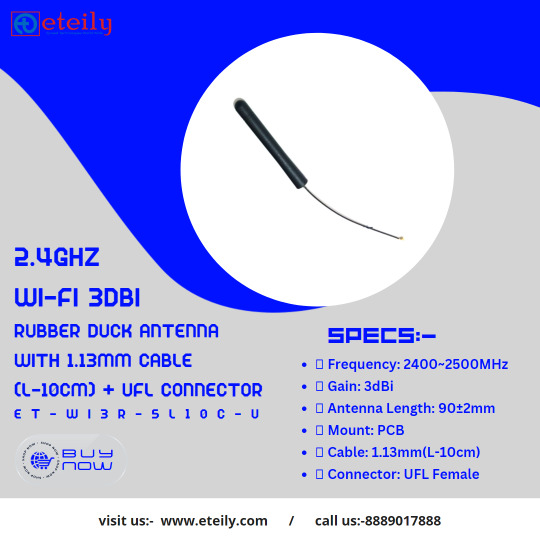
2.4 GHz Wi-Fi 3dBi Rubber Duck Antenna Manufacturers in India
2.4GHz 3dBi Rubber Duck Antenna
Eteily manufactures a wide range of Rubber Duck Antennas covering a wide range of frequencies supporting all applications. Our antennas are designed to work in rugged environment yet durable providing promising and satisfied customer needs.
This 3dBi high performance, omnidirectional antenna provides broad coverage. It is ideally suited for GSM GPRS band applications as well as cellular applications.
Features & Application
Ground-plane Independent
Cellular Applications
Tilt and swivel design
Routers and Gateways
Compact Good performance Omni Directional Antenna
Eteily’s Rubber Duck Antenna is high performance, Omni-directional providing broad coverage with a Strong and Stable Signal. It is ABS enclosed antenna with IP65 Rated Enclosure. It is ideally suited for all RF Cellular Devices. This antenna features a rugged composite random with SMA Male connector. It is compact, lightweight and easy to install.
ABOUT US
We are top notch manufacturer of Antennas in India, We supply Antenna & RF Products Globally
#Rubber Duck Antenna Manufacturer#High-Performance Wi-Fi Rubber Duck Antennas#4G/5G Rubber Duck Antenna#Top Rubber Duck Antenna Manufacturers#865 – 868 MHz / 1dBi Gain Rubber Duck Antenna#Rubber Duck Antenna in Mumbai#3DBI GSM rubber Duck antenna 800#External Rubber Duck Antenna#Dual Band White Rubber Duck Antenna#868 Mhz Rubber Duck Antenna#rubber duck antenna in india#rubber duck antenna in delhi#rubber duck antenna in chennai#rubber duck antenna in bangalore#rubber duck antenna in Ahmedabad#rubber duck antenna in hyderabad#rubber duck antenna in gujrat#rubber duck antenna in madhyapradesh#rubber duck antenna in pune#high gain rubber duck antenna in india
2 notes
·
View notes
Text
This immediately reminded me of "That's so Raven" ... Eddie & Chelsea standing on top of each other, holding the phone antenna and a popsicle stick. I literally CANNOT find a picture of it. =/
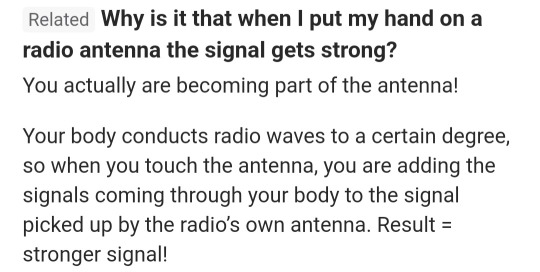
I think... this is inherently homoerotic
32K notes
·
View notes
Text
Unlocking the Future with Custom Antenna Design: Innovative Solutions for Optimized Connectivity & Performance
In today's interconnected world, where communication systems form the backbone of technological advancements, antennas are indispensable. Whether it's enabling your smartphone to receive signals, ensuring seamless connectivity for IoT devices, or facilitating complex satellite communications, antennas play a critical role. Among the many innovations in this field, custom antenna design stands out as a game-changer, offering tailored solutions to meet unique requirements in various industries.

The Need for Custom Antenna Design
Off-the-shelf antennas, while cost-effective and widely available, often fall short when specific operational parameters or unique environments come into play. For example, a drone designed for agricultural surveys may require an antenna capable of long-range communication in remote areas, while a wearable health monitoring device demands a compact, low-power antenna optimized for body-area networks. This is where custom antenna design comes in, providing solutions that align precisely with performance, size, frequency, and environmental requirements, Low Noise Amplifiers.
How Custom Antenna Design Works
The process of custom antenna design begins with a thorough understanding of the application. Engineers consider factors like operating frequency, gain, polarization, impedance, bandwidth, and the physical constraints of the device. Advanced simulation tools and software like CST Microwave Studio or HFSS are often employed to model the antenna and predict its performance before moving to prototyping.
Material selection is another critical aspect. Depending on the application, materials like copper, silver, or even flexible conductive polymers may be chosen. Once the design is finalized, prototypes are rigorously tested in anechoic chambers to ensure they meet the required specifications.
Industries Benefiting from Custom Antenna Design
Telecommunications: With the advent of 5G and beyond, custom antennas are being designed to handle higher frequencies and increased data rates. These antennas ensure robust signal transmission and reception in dense urban environments.
Automotive: Custom antennas are integral to modern vehicles equipped with advanced driver-assistance systems (ADAS), GPS, and in-car entertainment. These designs ensure seamless connectivity even in high-speed or remote driving conditions.
Healthcare: In medical devices like pacemakers, wearable health trackers, or telemedicine equipment, custom antennas provide reliable communication while minimizing interference and energy consumption.
Aerospace and Defense: Satellites, unmanned aerial vehicles (UAVs), and radar systems rely heavily on antennas tailored for extreme conditions, such as high altitudes, intense vibrations, or temperature fluctuations.
IoT and Smart Devices: From smart home appliances to industrial sensors, custom antenna designs enable compact, efficient, and low-power communication solutions.
The Future of Custom Antenna Design
As technologies like augmented reality (AR), autonomous systems, and space exploration continue to evolve, the demand for custom antennas is set to soar. Emerging materials such as graphene and metamaterials, along with AI-driven design optimization, are paving the way for even more efficient and innovative antenna solutions.
Moreover, sustainability is becoming a focal point in antenna design. Engineers are exploring eco-friendly materials and manufacturing processes to reduce the environmental impact of these essential components.
Conclusion
Custom antenna design is not just a technological advancement; it’s a necessity in a world where tailored solutions are key to staying ahead of the curve. By addressing specific challenges and optimizing performance, these designs unlock possibilities across diverse industries. As innovation marches forward, custom antennas will remain at the forefront, shaping the future of communication and connectivity.
#uhf vhf antennas#wifi antenna booster#vhf antennas#antenna development engineer#antenna design company#external wifi booster#improve wifi signal#vhf antenna#wifi signal enhancer#iridium external antenna
0 notes
Text
#NetAlly#Antenna#2.4Ghz#2.5Ghz#external#Rri Band#youtube#@inphi#@lucent#@marvell#@nokia#@alcatel#@xcalable#amazon#ebay
0 notes
Text
Understanding H685 Interfaces and Dimensions: A Comprehensive Guide
Dive into the intricacies of the H685 interfaces and dimensions with our detailed video guide. This video provides a thorough exploration of how H685 interfaces function and the critical dimensions that define their applications. Whether you're new to H685 or looking to deepen your understanding, this resource covers everything from basic concepts to advanced configurations. Gain insights into optimal usage scenarios, compatibility considerations, and practical tips for integrating H685 interfaces into your projects effectively. Expand your knowledge and enhance your proficiency with this indispensable video on H685 interfaces and dimensions.
0 notes
Text

2G/3G/4G Combo Screw Mount Antenna with RG174 Cable (L-3MTR) + SMA (M) St. Connector
A 2G/3G/4G combo screw mount antenna is a type of antenna designed to support multiple generations of cellular technology, namely 2G (GSM), 3G (UMTS), and 4G (LTE). These antennas are typically used in applications where there's a need for reliable cellular communication across different generations of networks.
The "screw mount" aspect refers to how the antenna is installed; it typically involves screwing the antenna onto a suitable surface, such as the roof of a vehicle or a fixed structure. This type of mounting provides stability and durability, making it suitable for outdoor and rugged environments.
#rf antenna#RF Antenna#celluler antenna#5g antenna#5G Internal Antenna#5G External Antenna#5G Outdoor Antenna#4G LTE Antenna#4G Internal Antenna#4G External Antenna#4G Outdoor Antenna#3G Antenna#3G Internal Antenna#3G External Antenna#3G Outdoor Antenna#2G/GSM Antenna#2G Internal Antenna#2G External Antenna#2G Outdoor Antenna#IoT Lora LPWAN#868MHz Antenna#433MHz Antenna#915MHz Antenna#925MHz Antenna
0 notes
Text
Sith Probe Droid
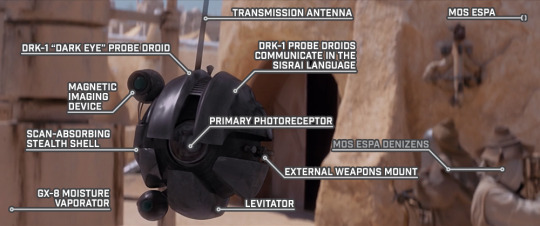
STAR WARS EPISODE I: The Phantom Menace 00:54:55
#Star Wars#Episode I#The Phantom Menace#Tatooine#Mos Espa#DRK-1 “Dark Eye” probe droid#unidentified Mos Espa denizen#transmission antenna#Sisrai#magnetic imaging device#scan-absorbing stealth shell#primary photoreceptor#external weapons mount#levitator#GX-8 moisture vaporator
1 note
·
View note
Note
For art request how about a fursona of one of the oiar workers. Up to you which character (includes externals n such)
shrimp time <3

[ID: A digital sketch of Sam from The Magnus Protocol as an anthropomorphic shrimp. His antennae are up and over his head, he is holding his hands near his chest, and he has a pleading expression. He is wearing a turtleneck, a cardigan, and trousers. He still has a mustache. end ID]
#fg's art#the magnus protocol#tmagp#samama khalid#furry#anthro#furry tmagp#fg's answers#asks#requests#originally i had sam down as a mouse or smth but then i was like wait. shrimp.#ALSO I'M SORRY IDK HOW TO DRAW SHRIMP MUCH LESS HOW TO ANTHRO THEM#i tried my best for the silly doodle
214 notes
·
View notes
Text
Dragons of Pantala (headcanon designs)
• Silkwings:

-Inherited from nightwings genes of fur on the chest and in their case they only progressed, thanks to which the wool is distributed throughout the abdomen, neck and front legs
-In addition, the shape of the scales is more like the scales of nightwings than the beetlewings. The hind legs are also inherited from nightwings (in general, silkwings closer to the nightwings while hivewongs to the beetlewings)
-Big Eyes
-Very long tongue
-Mouth are small and round
-Short, round ears
-Teeth are not very sharp, by structure more like the teeth of herbivores than of predators (transitional form from one diet to another; such a structure also came from the merger of nightwings (predators) and beetlewings (omnivorous, but preferring to eat plants; fed only under adverse conditions))
-Blood are beige, semi-transparent
-The shape before and after Metamorphosis is significantly different. The "caterpillars" (before metamorphosis) are covered with blistering scales, some have a greenish tinge, developed a cusptry at the mouth - the mouthparts helps the dragonets to feed (after metamorphosis only small mouthparts remain, which are rather rudimentary), very small antennae on the head, almost not functioning; their role replaces temporary growths on the lower jaw, which disappear after metamorphosis. Body consists of scales, fur missing
-After metamorphosis the skin color becomes much brighter, grow long antennae with fur at the end, also appears directly, the fur itself on some parts of the body
-The shape of the wings in some individuals may be different (similar to the butterfly wings after which they were named)
-Flamesilk dragons have patterns in the form of lights on their wings and also fire colors (red, orange, yellow) all over their body. Eyes are also very bright (before the metamorphosis it is not visible, also in normal silkwings eye color changes slightly, unlike flamesilk dragons). All this is a warning to other creatures that these dragons don't have ordinary silk (it is similar to how in our world poisonous animals have bright, warning coloring)
-Growth reaches 2-2.5 meters
*The design was based on butterflies and their caterpillars

• Hivewings:
-Round tail. Despite its external fleshiness, it is almost completely hollow and not overloaded with internal organs and muscles. It contains only organs of the reproductive system and a reservoir with poison. And even though there are these organs that contribute to the flying, 2 pairs of wings and a dense front of the body all compensate for it, and they restore balance
-The tail itself is motionless, only able to descend, in order to wound the opponent with a dagger. The front part of the body is more flexible.
-Ears are long but thin
-Blood as like silkwings, beige and semi-transparent, but has a darker shade
-The gait is more developed than silkwings
-Paw structure identical to beetlewings
-Thorns on the entire spine fall long, with a sharp end
-Horns are curved, facing the opposite direction
-Whites darkened but not entirely black, has a dark shade of the color of the iris
-Also prefer to eat plants, but unlike silkwings, their teeth are very sharp. The reason is defensive functions, the presence of poison in them.
-Mouth is sharp, triangular shape
-Growth reaches 2.5-3 meters
*The design was based on bees, wasps and some other insects
• Beetlewings:

-Horns curved and parallel to the mouth
-Sharp nose, able to pierce the opponent
-The mouthparts, which due to the long nose is necessary for beetlewings so that from the mouth as little food as possible. The long tongue also helps (but it is less than the silkwing's tongue)
-2 pair of wings: the first is twice as short as the second, it performs the role of elytra
-The second pair of wings can fold and hide under the first
-Double thorn on the tail. The structure of the tail is similar to the tail of hivewings (the tail of the beetlewings is longer than that of the hivewings)
-Large thorns on the spine
-Semi-transparent beige blood
-Whites are also darkened, but not as much as in their descendants, hivewings
-Ears are pointed but not very long
-Omnivores
-Growth reaches 2.5-3.5 meters
*The design was based on bugs and some other insects
• Leafwings:

-Horizontal eye shape
-The presence of a modified ruffs (they are related to rainwings)
-Wings, webbed spines, ruffs and ears are leaf-shaped, and they can be very different in each individual (often their appearance resembles the plant after which they were named)
-Their scales do not necessarily have a green tint in all individuals
-Long, multi-ended horns that resemble tree branches. Many bigger than rainwings
-Paw structure almost identical to rainwings
-Sapwings and poisonwings try to distinguish themselves by applying paint on small fragments of scales, often making a small pattern from this (the first are painted in pale colors, the second, on the contrary, in colorful, mostly consisting of red, yellow and orange shades)
-In addition to this poisonwings can sharpen their webbed spines and horns, make them sharper
-Height reaches 3-4 meters
*The design was based on trees, their leaves and partly rainwings
#wof oc art#wof art#wof#wof silkwing#silkwings#silkwing#wof hivewing#wings of fire hivewing#hivewing#hivewings#wings of fire headcanons#wings of fire silkwing#wings of fire art#wings of fire#wof beetlewing#beetlewing#leafwing#wof leafwing#leafwings#wings of fire leafwing#wof drawing#wof dragon#dragon art#artists on tumblr#my art#art#artwork#dragon#digital artist#wof headcanon
200 notes
·
View notes
Text
Round 1 - Phylum Arthropoda
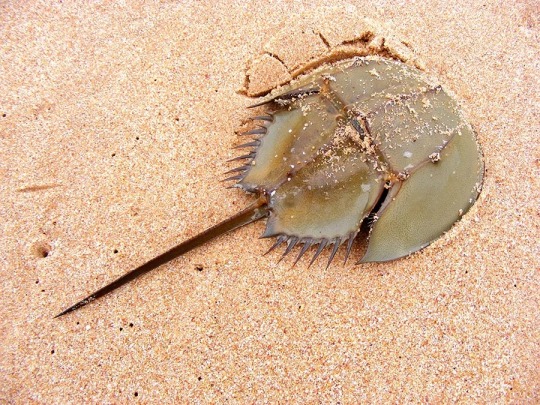



(Sources - 1, 2, 3, 4)
Arthropoda is a phylum of animals that have segmented bodies, possess a chitin exoskeleton, and have paired segmented appendages. They are colloquially called “bugs” though this is often only used for terrestrial arthropods, and sometimes only used for insects specifically.
After Nematoda, this is the most successful phylum, and it is far more diverse, with up to 10 million species! Arthropods account for 80% of all known living animal species. The three major subphyla include the Chelicerates (sea spiders, horseshoe crabs, arachnids, and the extinct eurypterids and chasmataspidids), the Myriapods (centipedes and millipedes), and the Crustaceans (shrimps, prawns, crabs, lobsters, crayfish, seed shrimp, branchiopods, fish lice, krill, remipedes, isopods, barnacles, copepods, opossum shrimps, amphipods, mantis shrimp, entognaths, and insects).
Arthropods are so diverse in fact that it is next to impossible for me to describe a model arthropod. They are important members of marine, freshwater, land, and air ecosystems and are one of only two major animal groups that have adapted to life in dry environments, the others being chordates. All arthropods have an exoskeleton and must molt as they grow, replacing their exoskeleton. Some arthropods go through a metamorphosis in this process. They have brains, a heart, and blood (called hemolymph, though some crustaceans and insects also use hemoglobin). They sense the world through small hairs called setae which are sensitive to vibration, air currents, and even chemicles in the air or water. Pressure sensors function similarly to eardrums. Antennae monitor humidity, moisture, temperature, sound, smell, and/or taste, depending on species. Most arthropods have sophisticated visual systems ranging from simple eyes (ocelli) which orient towards light, to compound eyes consisting of fifteen to several thousand independent ommatidia capable of forming images, detecting fast movement, or even seeing polarized or ultra-violet light. Some arthropods are hermaphroditic, some have more than two sexes, some reproduce by parthenogenesis, some by internal fertilization, some by external, some have complex courtship rituals, some lay eggs, some give live birth, some have prolonged maternal care. The first arthropods are known from the Ediacaran, before the Cambrian era.
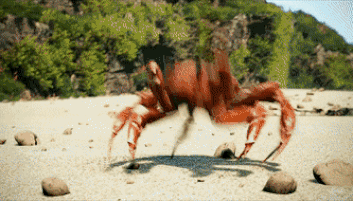
Propaganda below the cut:
Insects are the first animals to have achieved flight
The smallest arthropods are the parasitic crustaceans of the class Tantulocarida, some of which are less than 100 micrometres long. The largest arthropod is the Japanese Spider Crab (Macrocheira kaempferi) with a legspan of up to 4 metres (13 ft) long. The heaviest is the American Lobster (Homarus americanus), which can get up to 20 kilograms (44 lb).
Many arthropods are popular pets, including various species of crab, shrimp, isopod, crayfish, mantis shrimp, millipede, centipede, tarantula, true spider, scorpion, amblypygid, vinegaroon, mantis, cockroach, beetle, moth, and ant! Some are even domesticated, including silk moths and honeybees.
Many arthropods are eaten by humans as a delicacy, and farming insects for food is considered more sustainable than farming large chordates. These farmed arthropods are referred to as “minilivestock.”
Arthropods feature in a variety of ways in biomimicry: humans imitating elements of nature. For example, the cooling system of termite mounds has been imitated in architecture, and the internal structure of the dactyl clubs of mantis shrimp have been imitated to create more damage tolerant materials.
Spider venoms are being studied as a less harmful alternative to chemical pesticides, as they are deadly to insects but the great majority are harmless to vertebrates. They have also been studied and could have uses in treating cardiac arrhythmia, muscular dystrophy, glioma, Alzheimer's disease, strokes, and erectile dysfunction.
Shellac is a resin secreted by the female Lac Bug (Kerria lacca) on trees in the forests of India and Thailand. It is used as a brush-on colorant, food glaze, natural primer, sanding sealant, tannin-blocker, odour-blocker, stain, and high-gloss varnish. It was once used in electrical applications as an insulator, and was used to make phonograph and gramophone records until it was replaced by vinyl.
One of the biggest ecosystem services arthropods provide for humans is pollination. Crops where pollinator insects are essential include brazil nuts, cocoa beans, and fruits including kiwi, melons, and pumpkins. Crops where pollinator insects provide 40-90% of pollination include avocados, nuts like cashews and almonds, and fruits like apples, apricots, blueberries, cherries, mangoes, peaches, plums, pears, and raspberries. In crops where pollinators are not essential they still increase production and yield. Important pollinators include bees, flies, wasps, butterflies, and moths.
Many arthropods are sacred to humans. In Ancient Egypt, scarab beetles were used in art, religious ceremonies, and funerary practices, and were represented by the god Khepri. Bees supposedly grew from the tears of the sun god Ra, spilled across the desert sand. The goddess of healing venomous bites and stings, Serket, was depicted as a scorpion. Kalahari Desert's San People tell of a legendary hero, Mantis, who asked a bee to guide him to find the purpose of life. When the bee became weary from their search, he left the mantis on a floating flower, and planted a seed within him before passing from his exhaustion. The first human was born from this seed. In Akan folklore, the cunning trickster figure Anansi/Ananse is depicted as a spider. Western astrology uses the crab constellation, called Cancer, and the scorpion constellation, called Scorpio. Dragonflies symbolize pure water in Navajo tradition. In Anishinaabe culture, dreamcatchers are meant to represent spiderwebs and are used as a protective charm for infants. They originate from the Spider Grandmother, who takes care of the children and the people of the land in many Native American cultures. The Moche people of ancient Peru often depicted spiders and crabs in their art. In an Ancient Greek hymn, Eos, the goddess of the dawn, requests of Zeus to let her lover Tithonus live forever as an immortal. Tithonus became immortal, but not ageless, and eventually became so small, old, and shriveled that he turned into the first cicada. Another hymn sings of the Thriae, a trinity of Aegean bee nymphs. Native Athenians wore golden grasshopper brooches to symbolize that they were of pure, Athenian lineage. In an Ancient Sumerian poem, a fly helps the goddess Inanna when her husband Dumuzid is being chased by galla demons. In Japanese culture, butterflies carry many meanings, from being the souls of humans to symbols of youth to guides into the afterlife. Ancient Romans also believed that butterflies were the souls of the dead. Some of the Nagas of Manipur claim ancestry from a butterfly. Many cultures use the butterfly as a symbol of rebirth. And the list goes on…
cute crab eat a strawbebby:
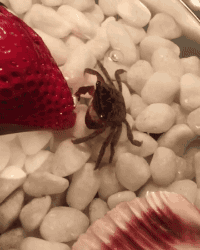
#round 1#animal polls#listen narrowing it down to just 4 images almost killed me#if arthropods don’t move on to round 2 I will have to take like an extra week off to mourn that I can’t show you all the cool bugs#there’s so many cool bugs guys#i chose the orchid mantis over a trilobite beetle and a poofy little bee fly cause I figured it had broader appeal#and used a horseshoe crab instead of a spider cause people are so Weird about spiders I worried it would impact the numbers#sigh#anyway I’m really hoping for Chordata Arthropoda Mollusca as top three#other phyla are all great but these three would make for the most interesting Round 2 imo#arthropoda
241 notes
·
View notes
Text
5G LPDA External Antenna for High-Gain Long-Range Connectivity
High-performance 5G LPDA external antenna designed for superior signal reception and long-range connectivity. Ideal for remote locations, industrial applications, and network enhancement. Supports wideband frequency coverage with durable weatherproof construction.
0 notes
Text
Wet Beast Wednesday: krill
The ocean is a huge place and food can be sparse. While the ocean receives plenty of energy in the form of sunlight, that energy needs to be converted into a form animals can consume. This is a job that krill have adopted with gusto. These little shrimpy critters live all over the world and play a vital role in the cycling of energy and nutrients. Krill are among the most common and important marine species, but many people overlook them or think of them as nothing but whale food. let's take a dive into the world of krill to show you that there's more there to appreciate.

(Image: a side view of an antarctic krill. It is a shrimp-like animal divided into a solid cephalothorax and flexible abdomen. On one end of the cephalothorax are the eyes and antennae and on the underside are multiple pairs of thin, feathery legs and gills. Along the segmented abdomen are paddle-like appendages. The tail is fanned out. The body is translucent with spots of red pigment. The cephalothorax looks green due to the presence of algae in the stomach. End ID)
There are 86 known species of krill in the order Euphausiacea. While they look a lot like shrimp or prawns, Euphausiacea is actually a sister group to Decapoda, which contains the shrimp, prawns, and most other crustaceans you've heard of. Krill can be distinguished from shrimp by the gills and number and anatomy of the limbs. Krill are zooplankton, a description which makes many people think they must be microscopic. In fact, plankton just means an organism is carried around by currents and cannot swim against them and has nothing to do with size. Most krill reach 1 to 2 centimeters as adults, but some species can get larger. The largest species, Thysanopoda cornuta, can reach 9.5 cm (3.75 in).

(Image: a swarm of krill in the ocean with so many members, it makes the water look red. End ID)
Krill anatomy is very similar to that of shrimp. Their bodies are divided into a cephalothorax, flexible abdomen, and tail fan. The cephalothorax is a fusion of the head (cephalon) and thorax. On the head are compound eyes, mouth, and antennae. Emerging from the thorax are legs. These legs are alternatively called pereiopods thoracopods, or thoracic legs. This is one of the key areas where krill are different from decapods. Decapods always have 5 pairs of thoracic legs and at least some of them are adapted for moving around on the ocean floor. Krill have a varying number of these legs and none are adapted for seafloor life. Krill spend their entire lives in the water column. Behind the legs are the gills, which are exposed to the water. The abdomen is long and flexible and has appendages called pleopods or swimmeretes that are used to assist in swimming and moving water over the gills. Decapods also have these. Finally is the tail fan, which is used in swimming and is also found in decapods. Krill exoskeletons are typically transparent with a bit of pigment on the top. All but one species of krill are bioluminescent, though its possible that the bioluminescence comes from their food. Krill have gills that are exposed to the water while Decapod gills are inside of their exoskeletons.
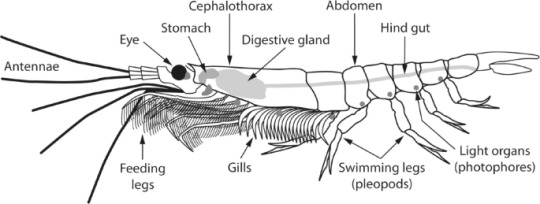
(Image: an anatomical diagram of a krill, with different external and internal body parts labeled. End ID. Source)
Krill are primarily filter-feeders that live in all oceans and in the shallow and deep seas. Most species feed on phytoplankton, especially diatoms, while other are omnivores or carnivores that hunt zooplankton and larval fish. The thoracic legs are covered in filamentous structures and will be held out in a formation called the feeding basket. Plankton passing through the basket will get caught and transferred to the mouth. Krill have a simple digestive tract with a two-chambered gut. The first chamber acts as a mill, crushing the hard shells of the diatoms to make digestion easier. Most krill practice diel vertical migration, a common ocean strategy where animals will remain at depth during the day and move closer to the surface at night. Some species remain in the deep sea all their lives. As krill feed, they become heavier and more sluggish and will sink, allowing the hungrier krill. Krill swim and feed in massive swarms.
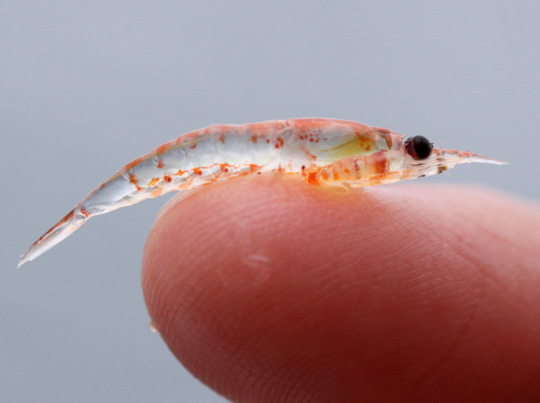
(Image: an antarctic krill balanced on a human finger, to show its size. It is barely longer than the first segment of the finger. End ID)
Krill are a vital part of ocean ecology. Energy is introduced to phytoplankton by the sun and used to produce the energy-storing molecule ATP. Krill eat the phytoplankton and convert that energy into a form larger animals can consume and digest. Whales can't gain energy from phytoplankton, but they can get that energy from krill. Krill are a vital food source for baleen whales, seals and sea lions, fish, squid, and other animals. By eating phytoplankton and then being eaten themselves, krill allow that energy to move through the entire food web. Krill also play a role in moving nutrients and carbon through the ocean. Carbon enters the ocean through runoff and carbon dioxide from the atmosphere entering the surface waters. Phytoplankton take in the carbon dioxide and covert it into forms of carbon that other organisms can use. The krill then eat the plankton, taking the carbon into themselves. Through feces, molted exoskeletons, and dead krill, that carbon can sink into the deep sea, where it can become sequestered in the sea floor. Similarly, nutrients can pass from krill to their predators or into the deep sea through feces and remains. Without krill and other animals filling similar roles, carbon and nutrients would have a much harder time reaching the deep ocean and larger animals wouldn't be able to access the energy stored in phytoplankton.

(Image: a diagram showing the highly complex process by which krill assist in moving carbon through the ocean. End ID. Source)
Being animals with exoskeletons, krill have to molt when they outgrow their current shells. Generally speaking, young krill will molt more often than older ones. Most crustaceans will slow down as they age, with each molt occurring further and further apart. This is not the case with krill, which keep molting at a relatively consistent rate through their lives. some species of krill can also get smaller after a molt instead of always getting bigger. This is used when food is unavailable, reducing the amount of energy the animal needs. Some species have been observed going 9 months between meals. Some species can spontaneously molt as a reaction to threats, leaving behind the empty exoskeleton as a decoy for predators.
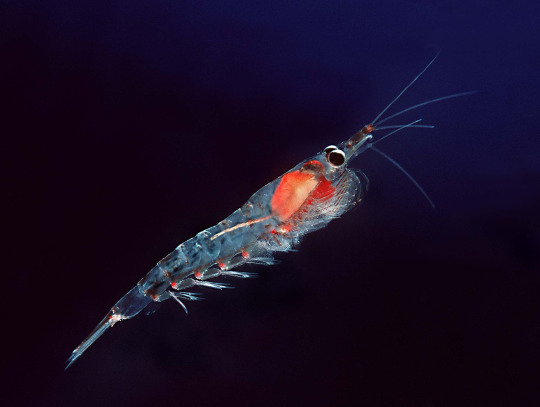
(Image: a northern krill. It is similar to the antarctic krill, but with a different arrangement of pigment. End ID)
Krill typically mate seasonally, though some tropical species can mate year-round. A female can produce thousands of eggs, which can make up a third of her body weight during mating season. Being a major prey animal, krill need to reproduce rapidly to keep their populations up. Most species will mate and produce eggs multiple times per mating season. Males approach females and deposit sacs of sperm into their genital openings. The females then produce eggs which can be treated in two ways. Most species will release their eggs into the water column and provide no further care. 29 species instead attach their eggs to a sac held by the rearmost thoracic legs and carry them until the eggs hatch. Some of these species hatch at a more mature stage. Once the eggs hatch, they have to swim upwards to reach the photic zone of the ocean, where photosynthesis can take place. Larvae progress through several developmental stages. Like other crustaceans, they start as a napulus larva, though some sac-brooders will hatvch at the more advanced pseudometanapulus stage. Either way, they progress then to the metanapulus stage. At this stage, they can lo longer subside on yolk and must reach the photic zone and metamorphose into the calyptosis stage, the first stage with a mouth, before starving. The final larval stage is called the furcilia, which passes through a number of molts. During each molt, the abdomen will grow another segment and pair of swimmeretes. After the final furcilia stage, the krill will resemble a small adult. Krill life spans vary baes on species, from less than a year to 10 years, with species in colder water usually living longer. Relatively few krill will die of old age. In the antarctic krill, Euphausia superba, over half the population is eaten every year.

(Image: several stages of krill development form egg to napulus to more advanced larval stages that look like the adult. End ID. Source)
Krill conservation needs vary by species, but in general, they are highly abundant and in little danger of extinction. Krill are among the most abundant animals in the world, with antarctic krill having one of the largest total biomass of any animal. Monitoring the krill population is extremely important because of their importance to the global ecosystem. Krill have been fished commercially for centuries, used as food, bait, supplements, animal feed, and for shrimp paste and fish oil. Most krill fishing takes place around Antarctica as the krill there are highly abundant and seen as cleaner. As the krill fishery grows, more studies need to be done on the impact on the population and the other species that rely on them. Krill are also impacted by global climate change, ocean acidification, and pollution. Krill can ingest microplastics, which can then be passed onto whatever eats them. Krill are keystone species, meaning they are crucial to the health of their environments. If they go, massive parts of the ocean ecosystem will collapse.

(Image: someone holding a pile of dozens of krill in their hands. End ID)
#wet beast wednesday#biology#ecology#zoology#marine biology#animal facts#invertebrates#invertiblr#crustacean#krill#antarctic krill#informative#educational#image described
121 notes
·
View notes
Text
Boost Your Connectivity: Ultimate Guide to WiFi Signal Enhancers for Stronger, Faster Internet
In today’s connected world, a strong and reliable WiFi signal is not just a luxury—it's a necessity. From working remotely to streaming our favorite shows, the need for fast, uninterrupted internet has never been more critical. However, weak WiFi signals can often disrupt our digital lives. This is where a WiFi signal enhancer can make a significant difference.

What is a WiFi Signal Enhancer?
A WiFi signal enhancer, also known as a range extender or booster, is a device designed to amplify your wireless signal and extend its coverage. Whether you live in a sprawling house or a multi-room apartment, a WiFi signal enhancer ensures that every corner of your home receives a strong and stable connection, Low Noise Amplifiers .
Signs You Need a WiFi Signal Enhancer
Dead Zones: Do you have areas in your home where the WiFi signal is non-existent? These dead zones are prime candidates for signal enhancement.
Slow Speeds: If your internet speed drops significantly as you move further from your router, a WiFi signal enhancer can help maintain consistency.
Multiple Devices: With smart homes becoming the norm, multiple devices competing for bandwidth can weaken the signal. A WiFi signal enhancer can support better distribution.
How Does a WiFi Signal Enhancer Work?
WiFi signal enhancers work by capturing your router's signal, amplifying it, and rebroadcasting it to cover more area. Think of it as a middleman that bridges the gap between your router and your devices. Most enhancers are easy to set up—simply plug them into a power outlet, sync them with your existing network, and place them in strategic locations.
Benefits of Using a WiFi Signal Enhancer
Eliminates Dead Zones: A signal enhancer can turn weak or non-existent WiFi spots into zones of full connectivity.
Improves Speed: With a stronger signal, you can enjoy faster browsing, smoother streaming, and better online gaming experiences.
Supports Smart Devices: From smart TVs to home assistants, a robust WiFi signal ensures all devices function seamlessly.
Choosing the Right WiFi Signal Enhancer
When selecting a WiFi signal enhancer, consider factors like compatibility, speed, range, and ease of installation. Some top-rated models even come with advanced features like dual-band functionality, built-in Ethernet ports, and mobile app controls.
Pro Tips for Optimal Performance
Strategic Placement: Place the enhancer midway between your router and the dead zone for the best results.
Reduce Interference: Keep the enhancer away from walls, metal objects, and electronic devices that may disrupt the signal.
Regular Updates: Ensure your WiFi enhancer's firmware is up to date for optimal performance.
Final Thoughts
A WiFi signal enhancer is a game-changer for anyone struggling with poor connectivity. It’s a simple, cost-effective solution that can transform your internet experience, making dead zones and buffering a thing of the past. Whether you’re working from home, streaming movies, or connecting smart devices, investing in a WiFi signal enhancer can help you stay connected and productive.
Ready to boost your WiFi game? Explore the latest WiFi signal enhancers and experience seamless connectivity today!
#uhf vhf antennas#wifi antenna booster#vhf antennas#antenna development engineer#antenna design company#external wifi booster#improve wifi signal#vhf antenna#wifi signal enhancer#iridium external antenna
0 notes
Note
I’m working on a robot character, and I wanted to know if it’s at all inappropriate to have the character (named Blip, uses he/it pronouns) have the “robot equivalent” of a traumatic brain injury and acquired facial differences, if that makes sense?
As it’s planned right now, he has one broken “eye” (kind of a camera lens) that no longer processes visual input, a damaged antenna and internal processor that sometimes misreads incoming signals leading to confusion, and a staticky slur to his speech (its voice would otherwise sound like a generic Siri-type thing, but it occasionally breaks into static). It also has visible damage to the side of its face with the broken eye. (Not a dented-in head, though, because I have a feeling that would conjure up ableist caricatures of brain injuries and I want to avoid that).
I just want to check if any of that sounds offensive, or if you have input on how to represent these features better. Thank you!
Hey! I'll answer for the part related to the facial difference and leave the brain injury to other mods.
Honestly this sounds fine to me. Just on the basis of this being a robot character named Blip, which seems quite silly (positive) and I enjoy seeing characters with FDs who aren't dead-serious and joyless all the time. The fact that he's not human (or even too humanoid, from the description) also helps since a lot of the negative tropes specifically affect how real humans are seen, if you're portraying an anthropomorphized computer then that's just very different. I don't think anyone would see a real person without an eye and think of a robot which avoids the entire "ableds think it's normal to compare a burn survivor they saw in the grocery store to Freddy Krueger" problem, even if you do end up falling into a trope with this character.
Definitely a good call in avoiding the indented skull* since the way it's generally used is a caricature and a borderline dogwhistle at this point. If you want to show that there was some sort of injury on the side of Blip's head, you could give him a different colored-metal plate there (or whatever else it's made out of), or give it a shiny texture to contrast with the rest of him being matte, make the damaged part thicker, etc. If his eye was damaged and is camera-like, you could have the shutter not close, or not move, or otherwise work differently from the other one (that's how my own ptosis would translate into a robot character... I think).
*Craniotomy, craniectomy, congenital cranial conditions, these are all real things that real people have and live with, so this isn't to say that this is always a no-go, because it's not. However, one needs to be very careful and sensitive to represent it respectfully due to what I originally mentioned. I'd strongly advise going with a sensitivity reader if that's something anyone reading this would want to include in their writing or art, and this aspect should be taken under consideration from the starting concept of the character.
For last advice, I'd try to not describe him "broken" as a whole if you're trying to represent him as disabled, since the whole "disabled people are broken". Not that it's wrong to refer to a body part like a leg or an eye as broken if one wants to do that; I mean referring like that to the entire person (or robot). I mention it since it's a common thing when it comes to robot fiction etc. but might come off weird in the context of an obviously disabled one.
I hope this helps,
mod Sasza
Hello,
As the human brain is basically a computer and our brain injuries are basically damage to that computer that changes how to computer functions, having a robot character with a TBI is a fairly easy thing to do. Damage to a human's sensory cortex (part of the cerebrum, one of three main parts of the brain) can cause sensory symptoms like the ones you're describing. This damage would be in his equivalent of the parietal lobe, which uses the information provided by external senses to navigate and have spacial sense, the temporal lobe, which has the auditory cortex and also helps with processing visual input and doing things like speech and reading, or the optical lobe, which is responsible for visual processing. If you'd like your character to have a more human brain in structure, you can look into other abilities that might be affected. But you can also just design his brain however you want it to be designed and that works, too, since he has a reason for his brain not being accurate to a human's brain.
Slurred speech is definitely a symptom that can come of a traumatic brain injury, especially a brain injury to the temporal lobe, and what he has also kind of sounds like a stutter or maybe him trailing off, which can also be issues we get.
And yes, I agree with Sasza about the dented head, definitely a good thing to avoid. If you want, you could incorporate a metal plate implanted on his "skull," which is a medical treatment for certain types of skull injuries to prevent complications and also to give the skull a more normal shape, which is called a cranioplasty.
Everything sounds good on the traumatic brain injury front
Mod Aaron
68 notes
·
View notes